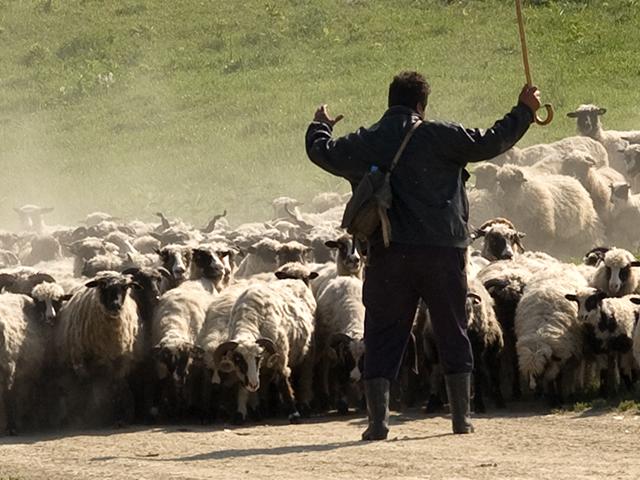THE EXPLANATION GIVEN FOR THE SAMADHIS OF SAVITARKA AND NIRVITARKA ALSO EXPLAINS THE HIGHER STATES OF SAMADHI, BUT IN THE HIGHER STATES OF SAVICHARA AND NIRVICHARA, THE OBJECTS OF MEDITATION ARE MORE SUBTLE.
By and by, the object of meditation has to be made more and more subtle. For example, you can meditate on a rock, or you can meditate on a flower, or you can meditate on the fragrance of the flower, or you can meditate on the meditator. And then things go subtle and subtle and subtle and subtle. For example, you can meditate on the sound aum. The first meditation is to say it loudly so it resounds all around you. It becomes a temple of sound all around you: aum, aum, aum. You create vibrations all around you – gross, the first step. Then you close your mouth. Now you don’t say it loudly. Inside you say, aum, aum, aum. Lips are not allowed to move, not even the tongue. Without the tongue and without the lips you say, aum. Now you create an inner atmosphere, inner climate of aum. The object has become subtle. Then the third step: you don’t even recite it, you simply listen to it. You change the position – from the doer, you move to a passivity of a listener. In the third state you don’t pronounce the aum inside also. You simply sit and you hear the sound. It comes because it is there. You are not silent; that’s why you cannot hear it.
Aum is not a word of any human language. It doesn’t mean anything. That’s why Hindus don’t write it in the usual alphabetical order. No, they have made a separate form for it just to distinguish it, that this is not part of the alphabet. It exists on its own, separate, and it means nothing. It is not a word of human language. It is the sound of the very existence itself; the sound of the soundless, the sound of the silence. When everything is silent then it is heard. So you become the hearer. It goes on and on, more and more subtle. And in the fourth stage you simply forget about everything: the doer, and the hearer, and the sound – everything. In the fourth stage there is nothing.
You must have seen ten oxherding pictures of Zen. In the first picture a man is looking for his ox – the ox has gone somewhere in the wild forest, no sign, no footprints – just looking all around, trees and trees and trees. In the second picture he looks happier – footprints have been found. In the third he seems a little bewildered – just the back of the ox is seen near a tree, but difficult to distinguish. The forest is wild, thick. Maybe it is just a hallucination that he is seeing the back of the ox; it may be just a part of the tree, and he may be projecting. Then in the fourth, he has caught hold of the tail. In the fifth, he is controlled by the whip; now the ox is in his power. In the sixth, he is riding on the ox. In the seventh, he is coming back towards the home with a flute, singing a song, riding on the ox. In the seventh, the ox in the stable, he is in the home, happy; the ox has been found. In the eighth, there is nothing; the ox has been found, and the ox and the seeker, the seeker and the sought, both have disappeared. The search is over.
In the ancient days these were the eight pictures. It was a complete set. The emptiness is the last. But then a great Master added two more pictures. The ninth – the man is back, again there. And in the tenth not only the man is back, he has gone to purchase a few things to the market, and not only things, he is carrying a bottle of wine. This is really beautiful. This is complete. If it ends in emptiness, something is incomplete. The man is back again, and not only back, he is in the market. Not only in the market, he has purchased a bottle of wine.
The whole becomes more and more subtle, more and more subtle. A moment comes when you will feel it is the perfect, the most subtle. When everything becomes empty and there is no picture, the seeker and the sought both have disappeared. But this is not really the end. There is still a subtleness. The man comes back to the world totally transformed. He is no more the old self – reborn, and when you are reborn, the world is also not the same. The wine is wine no more, the poison is no more poison, the market is no more market. Now everything is accepted. It is beautiful. Now he is celebrating. That is the symbol: the wine.
More and more subtle becomes the search, and more and more stronger becomes the consciousness. And a moment comes when the consciousness is so strong that you live like an ordinary being in the world, without fear. But move with Patanjali step by step. The objects of meditation are more and more subtle.
THE PROVINCE OF SAMADHI THAT IS CONNECTED WITH THESE FINER OBJECTS EXTENDS UP TO THE FORMLESS STAGE OF THE SUBTLE ENERGIES.
This is the eighth picture. The province of samadhi that is connected with these finer objects becomes more and more finer, and a moment comes when the form disappears and it is formless.
… EXTENDS UP TO THE FORMLESS STAGE OF THE SUBTLE ENERGIES.
The energies are so subtle you cannot make a picture out of them, you cannot carve them; only the emptiness can show them: a zero – eighth picture. By and by you will understand how these two other remaining pictures come in.
Patanjali – I call him the scientist of the religious world, the mathematician of mysticism, the logician of the illogical. Two opposites meet in him. If a scientist reads Patanjali’s Yoga Sutras he will understand immediately. A Wittgenstein, a logical mind, will feel immediately an affinity with Patanjali. He’s absolutely logical. And if he leads you towards the illogical, he leads you in such logical steps you never know when he has left the logic and taken you beyond it. He moves like a philosopher, a thinker, and makes so subtle distinctions that the moment he takes you into nirvichara, into no-contemplation, you will not be able to watch when the jump has been taken. He has cut the jump into many small steps. With Patanjali you will never feel fear, because he knows where you will feel fear. He cuts the steps smaller and smaller, almost as if you move on the plain ground. He takes you so slowly that you cannot observe when the jump has happened, when you have crossed the boundary. And he is also a poet, a mystic – a very rare combination. Mystics are there, like Tilopa; great poets are there like the rishis of Upanishads, great logicians are there like Aristotle, but you cannot find a Patanjali. He is such a combination that since him there has been no one who can be compared to him. It is very easy to be a poet because you are out of one piece. It is very easy to be a logician – you are made of one piece. It is almost impossible to be a Patanjali because you comprehend so many opposites, and in such a beautiful harmony he combines them all. That’s why he has become the alpha and the omega of the whole tradition of yoga.
In fact, it was not he who invented yoga; yoga is far ancient. Yoga had been there for many centuries before Patanjali. He is not the discoverer, but he almost became the discoverer and founder just because of this rare combination of his personality. Many people had worked before him and almost everything was known, but yoga was waiting for a Patanjali. And suddenly, when Patanjali spoke about it, everything fell in line and he became the founder. He was not the founder, but his personality is such a combination of opposites, he comprehends in himself such incomprehensible elements, he became the founder – almost the founder. Now yoga will always be known with Patanjali. Since Patanjali, many have again worked and many have reached new corners of the world of yoga, but Patanjali towers like an Everest. It seems almost impossible anybody ever will be able to tower higher than Patanjali – almost impossible. This rare combination is impossible. To be a logician and to be a poet and to be a mystic, and not of ordinary talents… It is possible: you can be a logician, a great logician, and a very ordinary poet. You can be a great poet and a very ordinary logician, third-rate – that’s possible, that’s not very difficult. Patanjali is a genius logician, a genius poet, and a genius mystic; Aristotle, Kalidas and Tilopa all rolled in one – hence the appeal.
Try to understand Patanjali as deeply as possible, because he will help you. Zen Masters won’t be of much help. You can enjoy them – beautiful phenomena. You can be awe-struck, you can be filled with wonder, but they won’t help you. Rarely somebody will be able within you who can take the courage and jump into the abyss. Patanjali will be of much help. He can become the very foundation of your being, and he can lead you, by and by. He understands you more than anybody else. He looks at you and he tries to speak the language that the last amongst you will be able to understand. He is not only a Master, he is a great teacher also.
Educationists know that a great teacher is not one who can be understood only by the topmost few students in the class, just the first benchers, four or five in a class of fifty. He is not a great teacher. A great teacher is one who can be understood by the last benchers. Patanjali is not only a Master, he is a teacher also. Krishnamurti is a Master, Tilopa is a Master – but not teachers. They can be understood only by the topmost. This is the problem – the topmost need not understand. They can go by themselves. Even without Krishnamurti they will move into the ocean and reach to the other shore; a few days sooner or later, that’s all. The last benchers who cannot move on their own, Patanjali is for them. He starts from the lowest and he reaches to the highest. His help is for all. He is not for the chosen few.
Tags: Patanjali Yoga Sutra 13.2 Province Of Samadhi










